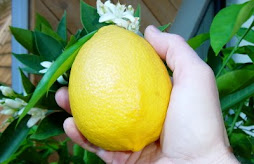I recently discovered that to most Americans, peanut butter equals JIF. I'll hold back my gasps of horror to offer my suggestion. To me, peanut butter equals peanuts and perhaps some sea salt--no more. It contains no added sugar or hydrogenated oils. Have you checked out the ingredient label of your peanut butter of choice? You'd be surprised to find substances that really don't belong.
A complaint about natural peanut butter is that it has to be stirred. The natural oils settle on top and must be stirred in when the jar is first opened. Additionally, natural peanut butter should be refrigerated. But this is more than worth it because natural peanut butter is far healthier and tastes far better.
Tip: turn the unopened jar of peanut butter upsidedown for a couple days before opening the first time. This will make stirring easier because the oil will get to the bottom of the jar where the peanut butter is prone to become rock hard.
While peanut butter may not be the absolute purest, healthiest choice on the planet, it still has lots of nutrition to offer such as protein, fiber, folate, and niacin..... hey, I did survive on it for a couple decades afterall...
The primary risk of peanuts is contamination by mold, particularly aflatoxins which are very toxic and can affect the liver. Fortunately, the FDA has established some regulation to help protect humans and animals. My advice is to always purchase organic, natural peanut butter from a company who cares. A glass jar is preferable over plastic also :)
Tip: Sprinkle nutritional yeast on your peanut butter snacks for extra B vitamins. It's good. I've been doing that since childhood too.
If you are particularly worried about aflatoxins, increase the chlorophyll in your diet (which you really should do anyway!) as chlorophyll blocks absorption of toxic carcinogens, according to this article from Natural News. Take the suggestion from Mike Adams and drink some parsley juice. Add it to your green smoothie or put it through a twin-screw juicer such as the Greenstar: Tribest Green Star 3000 Deluxe Juicer/Juice Extractor
Try out this juice combination:
- 2 organic granny smith apples
- 1/2 organic cucumber
- 1/2 head of organic celery
- 1 lemon
- 1" of ginger root
- 1 bunch of organic parsley














1 comment:
Agreed! Organic, natural peanut butter is the best! Along with storing the jar upside down before opening, I scoop out all the peanut butter and stir it using my mixer. I have noticed that the oils incorporate better and because of this, the peanut butter doesn't get rock hard after sitting in the refrigerator. Yes, it's a lot more work that just stirring it around in the jar, but the effort is well worth it later.
Post a Comment